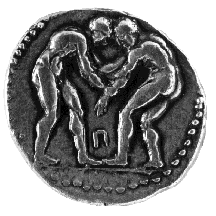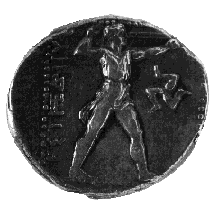



(37) Aspendos, Pamphylia (Turkey) - AR stater, 4th c. B.C.,
10.85 g. (inv. 91.087).
Obverse: In circle of dots, two wrestlers engaged; ![]() between
them.
between
them.
Reverse: In dotted incuse square, slinger wearing short
chiton discharging r.; triskeles in r. field; ![]() : of Aspendos in local dialect and Greek script.
: of Aspendos in local dialect and Greek script.
Provenance: Coin Galleries, 1971.
Bibliography: C.M. Kraay, Archaic and Classical Greek
Coins (Berkeley and Los Angeles (1976); N. Olçay and O. Mørkholm,
"The Coin Hoard from Podalia," Numismatic Chronicle, 1971,
pp. 18-29.
Aspendos was a Greek colony and strategic port and naval base in Persian
territory, on the river Eurymedon in Pamphylia. There were no coins issued
in the area until c. 460 B.C., after which Aspendos struck large numbers
of coins on the Persian weight standard, widely used in western Asia Minor.
Beginning about 400 B.C. Aspendos issued a new series of staters, which
were struck to the end of the fourth century. These depict wrestlers on
the obverse and a slinger on the reverse. The types are unusual for their
detailed depiction of full-length bodies in active athletic poses. It has
been suggested that the slinger was chosen for the similarity of the Greek
word for sling, sphendone, to the name of the town. In the right
field of the reverse is the city's badge, the triskeles, three human
legs connected in a wheel-like formation, which had occupied a more prominent
position on the obverse of earlier Aspendian coins.
R.H.L.



All contents copyright (c) 1996.
Lawrence University
All rights reserved.